A Private Tour today in North Norfolk, for visitors from the USA. The target was to see a good variety of species, rather than chasing rarities, so we set off to see as many different birds as we could, in as relaxed a fashion as possible. It was windy and cold to start, but we managed to work round the April showers and had some brighter, calmer weather to end the day.
We met in Wells and a quick early morning detour brought us to the local Black-headed Gull colony. A careful scan and we found a smart adult Mediterranean Gull in with them, its jet black head setting it apart from the ironically named Black-headed Gulls (which actually have chocolate brown hoods in summer). It was perched down in the marram grass, preening, so we couldn’t see its white wing tips, but we did admire its contrasting white eye shadow and heavy, deep-red bill.
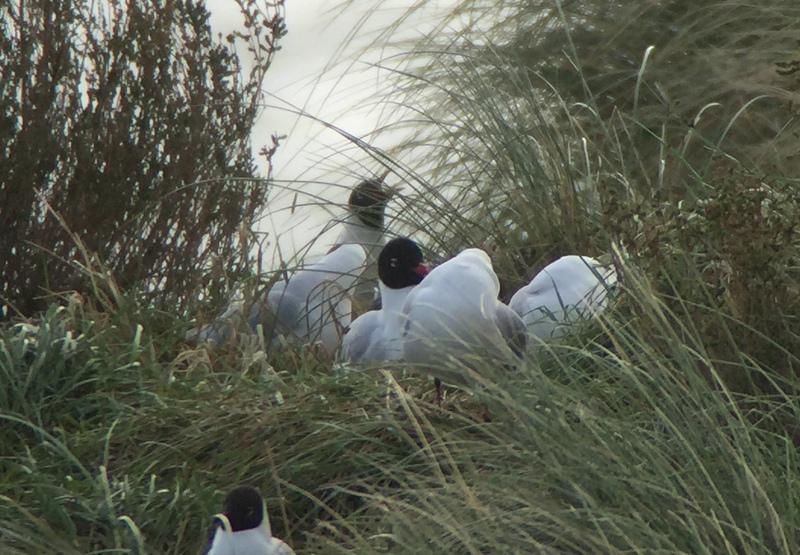 Mediterranean Gull – just after a Black-headed Gull landed in front
Mediterranean Gull – just after a Black-headed Gull landed in front
There were lots of Brent Geese flying around over the saltmarsh but it was cold and exposed in the brisk wind, so we beat a hasty retreat after we had seen our target bird here. A Chiffchaff was singing from the trees as we made our way back to the car.
There had been a few Pink-footed Geese at Lady Anne’s Drive yesterday, so we made a quick stop there on our way west. On the way, a Red Kite drifted over the field beside the road. There was no sign of the geese today, but we did get to see a nice selection of other wildfowl – Shelduck, Gadwall, Teal and Shoveler. The Northern Lapwing stole the show though – such stunning birds, we are all too often in danger of taking them for granted but they are appreciated in all their glory by those who have not seen them before! The spiky black crest and iridescent green upperparts really stand out.
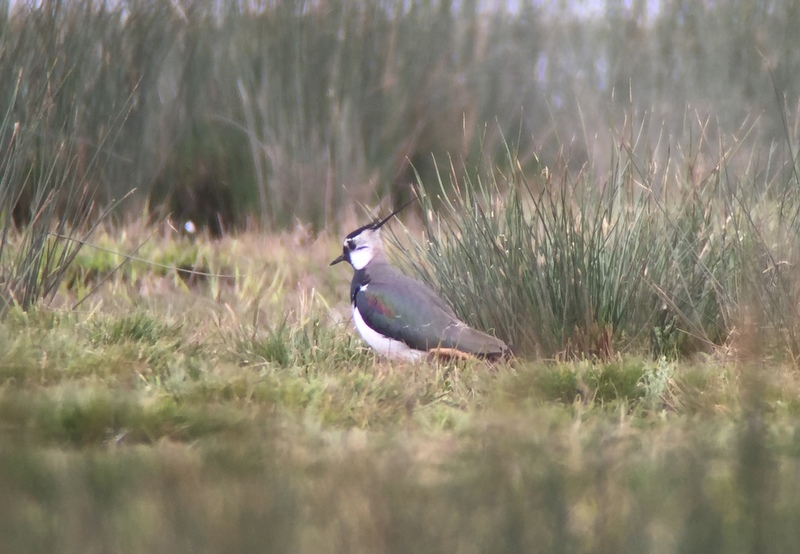 Lapwing – one or our most stunning birds
Lapwing – one or our most stunning birds
There were also a couple of Mistle Thrushes out on the grass, big bold and heavily spotted below. The plan was not to linger here, and we were on our way back up the Drive when a small bird appeared on the verge. A smart male Wheatear, he flicked up onto a fence post when we stopped and then dropped down into the field beyond out of view when we tried to reverse back. This bird was in exactly the same place we had seen a Wheatear yesterday, so presumably it was the same one.
Our next stop was at Burnham Overy Staithe. On the way there, we had a brief stop on the main road to admire a pair of Grey Partridge in a field before approaching traffic meant we had to move on. We parked in the harbour car park and set off along the seawall.
We could hear a Chiffchaff singing from the bushes and possibly a second was then spotted flitting around in the Alexanders on the bank. So many of the Chiffchaffs have already arrived that it can be hard to tell now which are onward-bound migrants stopping off and which are here for the summer. A Willow Warbler which flew along the bank towards us was most likely a migrant. It landed in the brambles close by, before flying on towards the village. The Sedge Warblers are also in in numbers now and we could here several singing from the brambles below the seawall, a constant rolling medley of trills, whistles and scratchy notes. We got one in the scope and admired its bold pale supercilium.
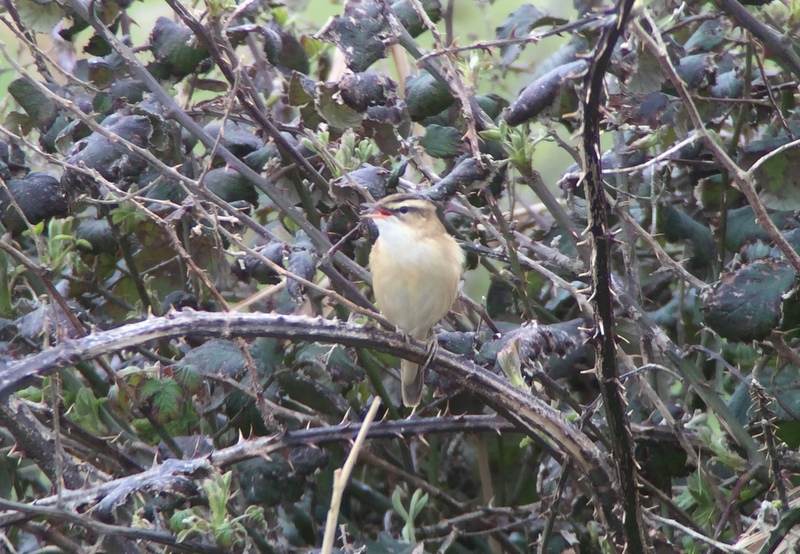 Sedge Warbler – several were singing along the seawall
Sedge Warbler – several were singing along the seawall
We could hear one or two Little Grebes cackling maniacally from the reeds and eventually spotted one in the ditch, although it kept diving as it swam away from us. There were several Tufted Ducks in the ditch too.
On the other side of the seawall, a Spoonbill took off from the saltmarsh but unfortunately flew away from us. We had OK flight views, if a little distant – we could see the long bill held out in front, the neck outstretched in flight. We turned our attention to the waders in the harbour. As well as the Redshanks and Oystercatchers, a little group of Black-tailed Godwits and Knot were feeding on the mud just below the bank. The Black-tailed Godwits are now really starting to acquire their rusty summer plumage, but the Knots were still in full winter attire. Known as Red Knot on North America, after their summer garb, they should probably be called Grey Knot here!
 Knot – still in their grey winter plumage
Knot – still in their grey winter plumage
Out on the sandbank in the middle of the harbour channel, we could see a group of Brent Geese. Nearby, were some small waders and a closer look through the scope revealed they were Ringed Plover, with a single silvery grey Sanderling in with them. There were actually quite a lot of Ringed Plover out on the sand, perhaps birds on their way further north, rather than just the small number of birds which breed here. There was also a Grey Plover with them and a little further along were a few Bar-tailed Godwit. Over on the other side of the channel we could see an Avocet too.
We walked on to the reedbed, which seemed a little quite at first today. We finally located some of the few lingering here Pink-footed Geese – a flock of about thirty was out on the grazing marshes beyond. While we were watching them, we heard a Bittern booming from the reeds – a remarkable sound, a little like a foghorn! We dropped down off the seawall onto the path below, out of the wind, to get a better listen to it. It boomed several times while we were there, not far into the reeds today, but it stayed well hidden. A Cetti’s Warbler sang from deep in the bushes, similarly reluctant to show itself.
A glimpse of a Snipe dropping down onto the grazing marshes saw us walk a little further on and we were busy scanning the grass for it when a Spoonbill flew just above our heads. It may have come up from the reedbed pool and low over the reeds out of sight, but as it flew right over us we could see its spoon-shaped bill clearly. We could see grey clouds approaching from the west now, so we beat a hasty retreat and got back to the car just in time, as it started to rain.
A quick stop back at Holkham to use the facilities and we made a short diversion into the Park to have a look at Holkham Hall. As well as the resident herd of Fallow Deer, there was a large flock of feral Barnacle Geese on the lawn. Over by the lake, a pair of Grey Herons chased each other off over the grass, and we could see several Swallows hawking for insects around the island.
We took a diversion inland from here, to try to find some farmland birds. A couple more Red Kites hung in the air next to the road. Another pair of Grey Partridge were feeding out on some water meadows. We stopped to look at a party of Rooks feeding in a field. The rain was intermittent but began to fall more heavily now, which meant the birds were a bit harder to find.
At Choseley, there were lots of Brown Hares and Red-legged Partridge in the fields. We stopped to watch three Wheatear which were making there way up the road, flitting between the hedges and occasionally landing in the road itself. We could see a Yellowhammer distantly on the wires, but then several flew in and landed in the bare field in front of us, including a very bright yellow-headed male. It was time for lunch now, so we headed on down to Titchwell.
After lunch, we made our way out to the Visitor Centre. The feeders in front were rather quiet, apart from a Chaffinch and a couple of tits. The feeders the other side looking similarly devoid of life at first and there was no sign of any Bramblings , so we we went for a quick look in the ditch by the main path. Almost immediately, we found the Water Rail feeding among some fallen branches on the bank, once again getting great views of this often very secretive species.
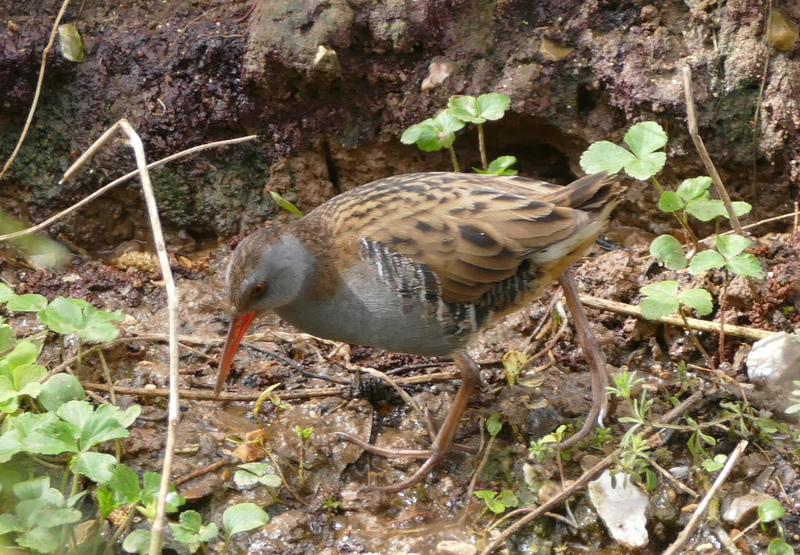 Water Rail – still feeding in the ditch by the main path
Water Rail – still feeding in the ditch by the main path
We could hear a Siskin singing from the alder trees above and when we turned round it was on the bird table below – a smart male.
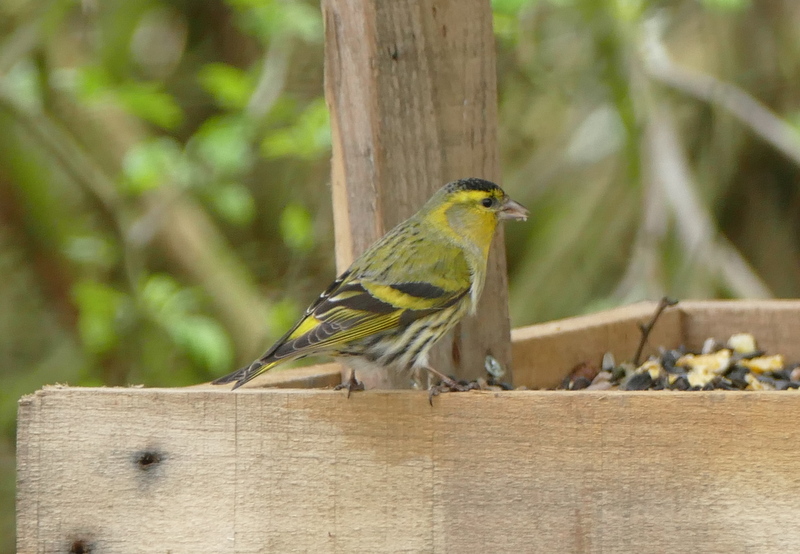 Siskin – a nice bright male on the bird table
Siskin – a nice bright male on the bird table
Back to the feeders again and quickly more birds started to appear now – a lovely bright green male Greenfinch dropped in, then a stunning Goldfinch. The Bramblings had obviously been hiding on the ground below the feeders, in amongst the wooden pallets, because first a female flew into the bushes, followed shortly after by a male. We got a good look at them while they were in the bushes, but when they dropped down to the ground again they were much harder to see once more.
While we were focused on the Bramblings one of the group saw a white shape fly across the grazing meadow beyond. It could only be one thing, so we hurried back over and sure enough there was a Barn Owl hunting out over the long grass. There is often a Barn Owl to be found here later in the afternoon, but this was an early outing even by its standards! It flew off away from us at first, then made a circuit back and right across in front of us, dropping down into the grass a couple of times.
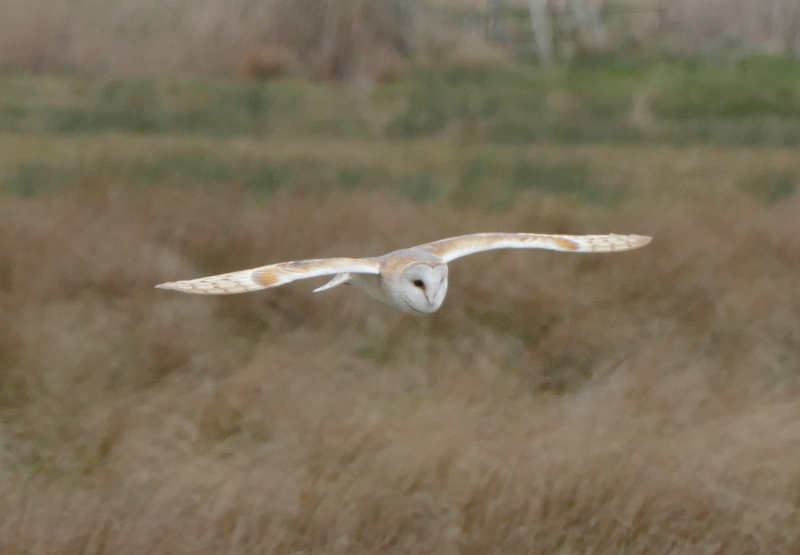 Barn Owl – out early over the grazing meadow today
Barn Owl – out early over the grazing meadow today
Even better, the Barn Owl then flew towards us and landed on the fence right at the front. It was half hidden behind some reeds at first, but then it helpfully flew along a couple of posts and landed again where we had a much clearer view. Stunning!
 Barn Owl – then perched obligingly on a fence post right in front
Barn Owl – then perched obligingly on a fence post right in front
When the Barn Owl finally flew off again, we made our way out onto the reserve. A pair of Long-tailed Tits were feeding in the sallows by the path.
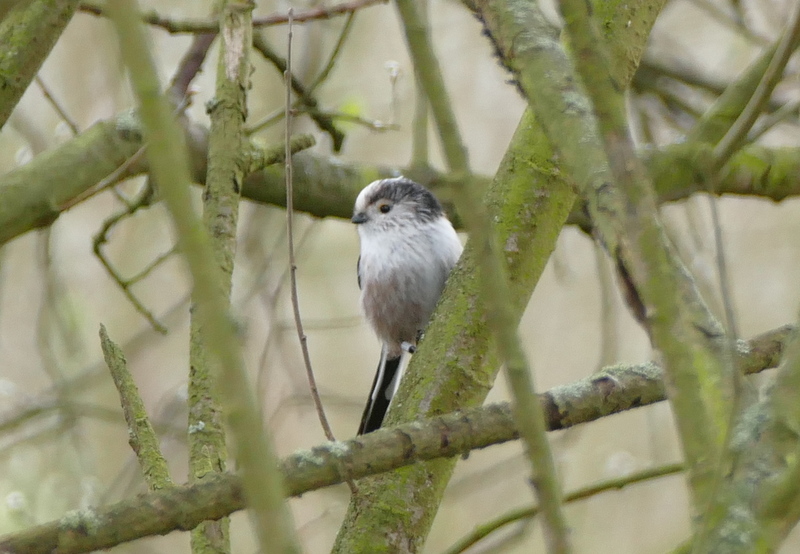 Long-tailed Tit – feeding in the sallows by the main path
Long-tailed Tit – feeding in the sallows by the main path
We stopped by the grazing meadow pool, which is still pretty much dried out, save for a couple of puddles. There were several wagtails out on the mud and a closer look through the scope confirmed there were at least four White Wagtails. The continental European version of our (mostly) British Pied Wagtail, they have a much paler grey back. Lurking right over at the back, half in the reeds, preening, we eventually found one of the Water Pipits. They are getting into summer plumage now, with a lovely pale pink wash on the breast. Nearby, even more obscured from view, we managed to locate another two Water Pipits. But there was no sign of any Little Ringed Plovers on here at this stage.
The reedbed pool on the way out yielded a distant Great Crested Grebe and a pair of Red-crested Pochard, plus a few Common Pochard. We could hear Bearded Tits pinging from the reeds, but they were not inclined to show themselves. Perhaps they were put off by the strength of the wind earlier, even if it was now starting to ease off. A Marsh Harrier perched up in one of the bushes in the reeds and, as we walked on towards the freshmarsh, one was displaying, dropping down out of the sky in a rollercoaster of tumbles, swoops and loop-the-loops.
The freshmarsh is still pretty full of water, so we didn’t stop at Island Hide today. There were lots of Brent Geese enjoying the conditions, flown in from feeding out on the saltmarsh to bathe and preen. We could see some very dark clouds gathering to the northwest and although we had thought they might miss us, it gradually became clear we were in for a heavy shower. We got to Parrinder Hide just as the rain started. All the birds either huddled down or flew off to find shelter elsewhere.
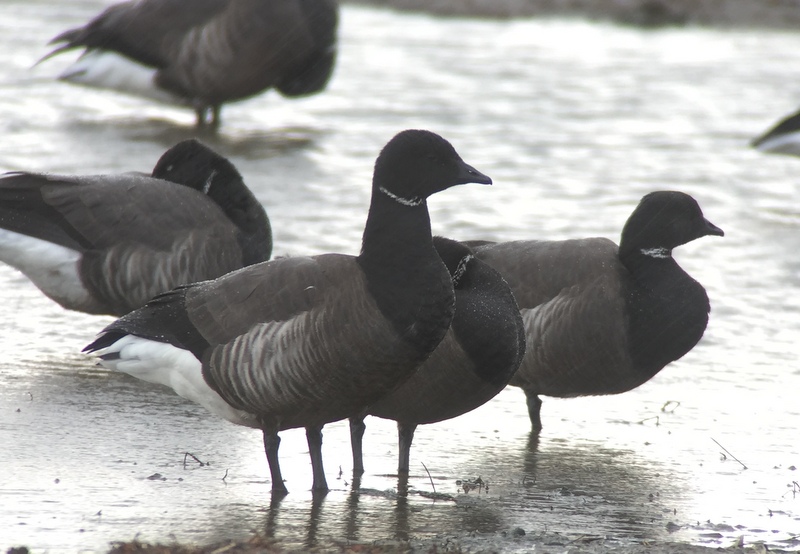 Brent Geese – just as the rain started to fall
Brent Geese – just as the rain started to fall
There were various distractions from the hide as the rain fell. A nice selection of duck included some smart Teal just below the hide. The Gadwall is one of the most under-rated of wildfowl and we had time to admire a drake on the mud, the intricate patterning of its plumage.
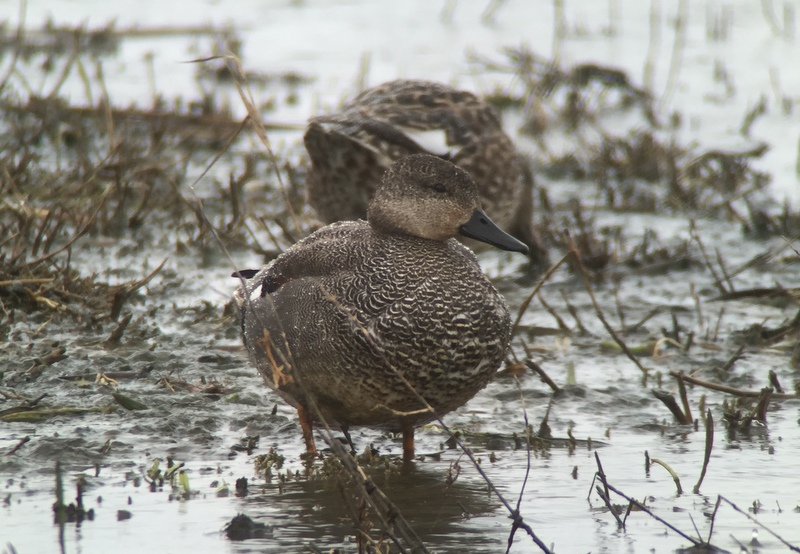 Gadwall – a drake with its intricately marked plumage
Gadwall – a drake with its intricately marked plumage
The water levels have started to drop a little, which might be encouraging some of the waders. A lone Snipe was feeding on the exposed mud along the edge of the bank, incredibly well camouflaged against the cut reeds and dead vegetation. A single Grey Plover flew in and started preening as the rain began to ease. Known as Black-bellied Plover in North America, we usually see them in the winter when they lack their black bellies – hence the name Grey Plover is more appropriate here.
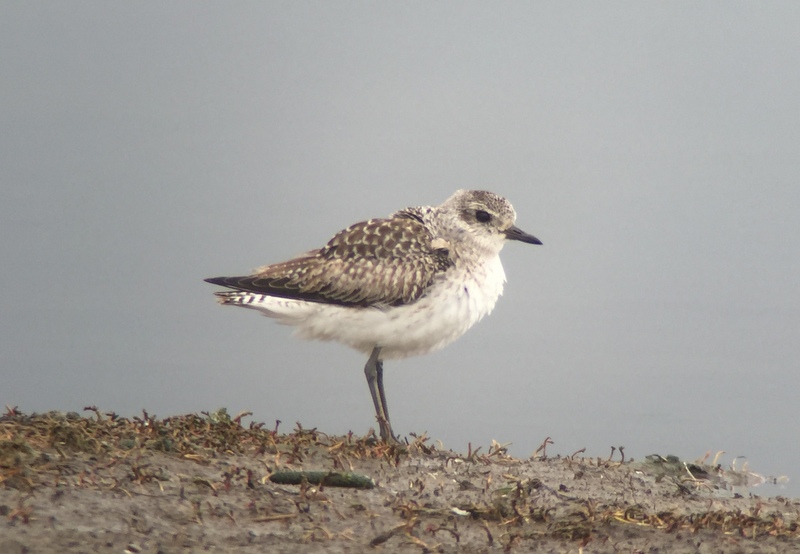 Grey Plover – flew in to preen as the rain eased
Grey Plover – flew in to preen as the rain eased
One the rain stopped, we made our way over to the other side of Parrinder Hide, overlooking the Volunteer Marsh. There were several Avocet just below the hide, and we watched as they fed, sweeping their bills from side to side through the shallow mud. Apart from lots of Shelduck, plus a few Redshank and more Grey Plover, there didn’t appear to be much else of note on here today.
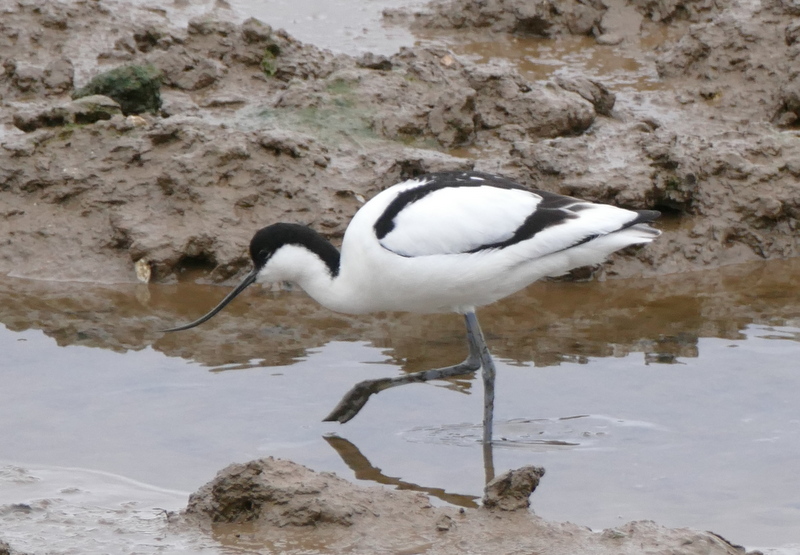 Avocet – more were on the Volunteer Marsh today
Avocet – more were on the Volunteer Marsh today
The Tidal Pools were also rather quiet, so we continued on to the beach. There was a little raft of Common Scoter just offshore. We had a look at them and talked about the distinguishing differences from the American equivalent, Black Scoter. Further over, out in the middle of the Wash, we could just make out a vast flock of Common Scoter looking a but like a distant oil slick. In the other direction, over towards Brancaster, we could see a little group of Red-breasted Merganser out on the sea.
The tide was coming in, but there were still a few waders out on the shore. We just had enough time to find a Turnstone and a small party of Dunlin, both additions to the day’s list, before all the waders were pushed off by the incoming sea. The dark clouds seemed to be missing us now, but with more out west, we decided to make our way back just in case.
Back at the reedbed pool, the Great Crested Grebe was now right down at the front. We had just got it in the scope when a second appeared and they started to display. At first, they swam to face each other, crests raised and proceeded to turn away in turn, preening their back feathers as they did so. After a minute or so, they seemed to lose interest and swam off in opposite directions, but a short while later the male swam back with a bill full of vegetation. This time they stood upright, paddling vigorously with their feet, breast to breast. They are fantastic looking birds and it is always a stunning display to watch.
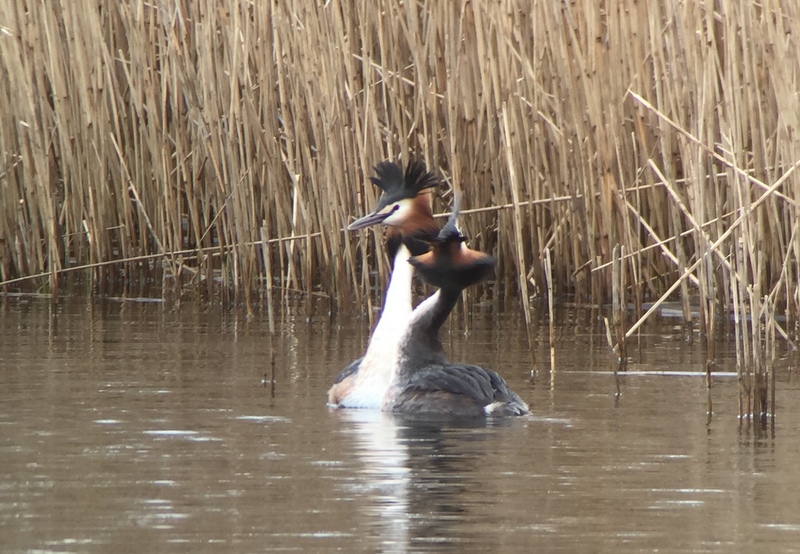 Great Crested Grebes – this pair were displaying today
Great Crested Grebes – this pair were displaying today
One of the drake Red-crested Pochard had also swum down to the front so we got a much better view of that too, orange punk hairstyle, bright coral-red bill, and all.
 Red-crested Pochard – showing well on the way back
Red-crested Pochard – showing well on the way back
We could hear the pinging calls of Bearded Tits again, but this time they sounded much closer. The wind had dropped and it was now quite calm and still, which probably helped. A quick scan and we picked up a small group working their way low down along the edge of the reeds just across the water. We got then in the scope and could see a couple of males and a female, the males with powder blue heads and black moustaches (not beards!). Even better, a pair then flew across to the reed by one of the pools just below the main path. We hurried back just in time to get really close views of them working their way across. Cracking views!
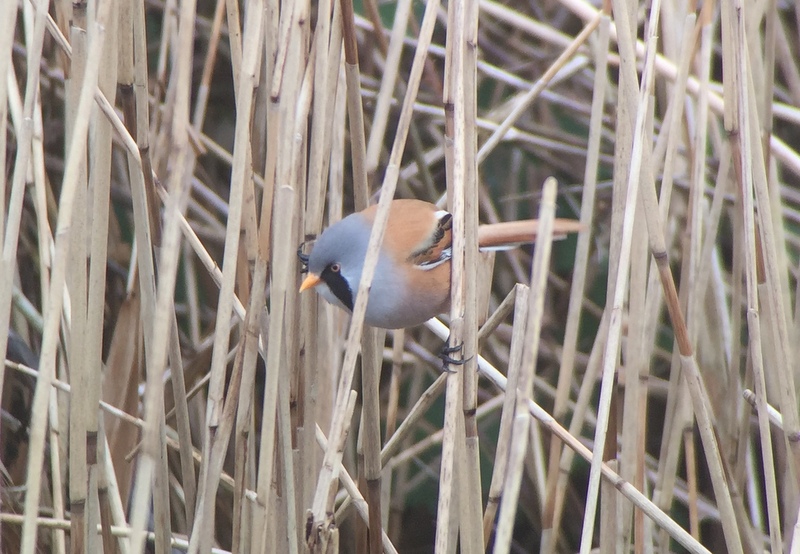
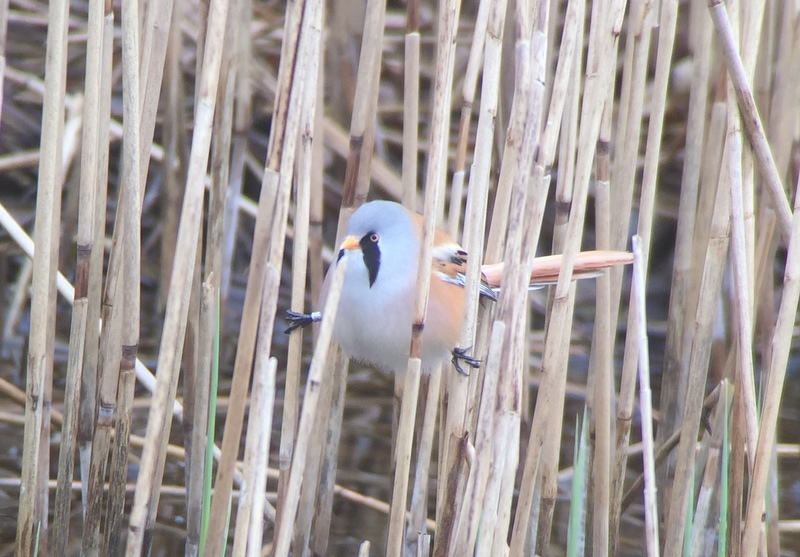
 Bearded Tit – a male striking various poses
Bearded Tit – a male striking various poses
The walk back was further enlivened with a much closer Water Pipit out on the grazing marsh ‘pool’. When we stopped to look at it, we could found two Little Ringed Plovers as well on here, lurking over towards the back. A Stoat ran along the far edge of the reeds an out across the mud, pursued as it did so by 8-10 wagtails, a mixture of Pied and White Wagtails. We then took a detour round via the Meadow Trail to the Visitor Centre, which was further rewarded with a Willow Warbler in the willows and a Goldcrest too.
Then it was time to call it a day and head back to Wells to finish. A last Wheatear on the hedge beside the road at Holkham rounded off the day.
















